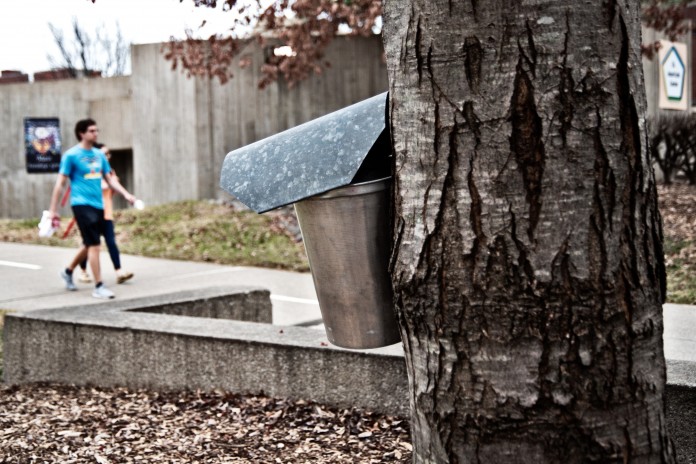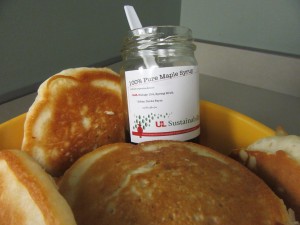Maple tapping project a first for Belknap Campus trees
On April 15, the University of Louisville Eco-Reps enjoyed a unique treat: Pancakes topped with 100-percent pure maple syrup made from the sap of Belknap Campus trees.
The tapping project was part of a curriculum unit in a special section of Biology 104, taught by Melissa Michael. Michael, who is working on a PhD at UofL in curriculum and instruction in science and early childhood elementary education, hoped the maple syrup project would inspire her students to pursue STEM careers. UofLNews had the chance to talk to Michael about the project.

UofLNews: Briefly describe your background?
Melissa Michael: I’ve taught for about 10 years: four years in south Atlanta (elementary school), three years in rural Kentucky (elementary school), one year private school, one year undergraduate biology at UofL and graduate assistantship in the education department. I have a bachelor’s of science in elementary education and a master’s degree in teacher leadership and environmental education endorsement, both from Georgetown College.
Teaching is my passion. I’ve taught and worked in some pretty tough areas. South Atlanta was no exception—kids throwing furniture, unsupportive administration. Teaching is hard. I’ve lived and breathed the pain and heartache of knowing that your students aren’t getting fed at home, that their basic needs aren’t being met, and I’m supposed to help them pass a state-mandated standardized test. I wanted to get my PhD to help teachers. To really help teachers.
I’m not quite sure how to do that yet as there are so many issues in education. Teachers are amazing, hardworking people and I wish that they got even a fraction of the praise and pay as movie stars and athletes.
UofLNews: How did you come up with the idea to teach this class in order to attract more women to the STEM (science, technology, engineering, math) fields?
Melissa Michael: Growing up I spent a lot of time outside. I would play in creeks and my backyard with my brother. My family and I, we would go camping. I would inspect and dissect insects. My mom would teach me about all of the plants and their benefits. We would take walks and she would teach me about trees. I soon learned to identify many trees. Any bug or plant we came across that we didn’t know about, we would look through our field guides and learn as much as we could about the specimen.
At the time, I did not know that I was doing science. I did not realize that was science until my master’s program where I found out about an environmental education certification program under Dr. Emily DeMoor at Georgetown College.
Through the program, I realized that I loved science. I soon wondered if there were kids and adults who were doing science but did not realize that they were doing science. I wondered too if there were many kids who would love science if only they were given the chance.
I started looking into the literature about science education and I found out that mostly Caucasian men are in science and not many women or minorities. With my background of working with kids from the inner city and as a woman, this news was disconcerting and I wanted to do something, but where do I start?
Through networking, I met Dr. Linda Fuselier in the biology department at UofL. She was very intrigued by my research interests and asked me if I wanted to teach a special section of a biology lab for non-science majors. I completely jumped at the chance.
I credit Dr. Fuselier for coming up with the idea of tapping the maple trees on campus. This project was a hope to motivate non-science majors to develop a love for science and for the outdoors. I taught this class without being paid. I did get course credit for teaching the class. However, I taught this class out of a love for education, for science and for students.
The hope was that undergraduate students would see that they do not have to be science majors to do science, and that science can be a part of their lives outside of the science classroom. That’s why we called in Dave Barker, a man whose job is with computers but has chosen to take on the hobby of tapping maples, to help us tap the trees. Dave provided the taps, buckets, drills, and all the supplies that we needed to collect the sap. In addition, Dave processed our sap into syrup at his Urban Ducks Farm. There’s about 30 to 50 gallons of sap to equal 1 gallon of syrup.
UofLNews: How many students are in the class?
Melissa Michael: 27 students
UofLNews: How did the maple syrup project work into the class. What else are you doing/studying in this class?
Melissa Michael: There were some frustrating parts with tapping the maple trees. Two of our drills stopped working the day we tapped the trees and then a day of syrup collection, one of our buckets got run over by a car. And we actually got stopped by campus police the day we tapped the maple trees. At first I was upset, but I was quickly thankful that students and staff were keeping an eye out for suspicious activity and that they were concerned about the trees.
In January, we did a lot of research about how to tap maple trees to make sure that we did not harm the trees and that we tapped correctly. We measured the dbh (diameter at breast height) of the maple trees on campus to see which ones were big enough to tap. In February, we tapped maple trees by drilling a hole 5/8 inches deep into the sapwood or xylem of the tree. This does not harm the tree. Then we used a rubber hammer to tap the spouts into the tree. We hung a bucket on the spout and covered the bucket with a lid. Then we waited for sap to flow.
Some of the trees began producing sap as soon as they were tapped. We used a refractometer to do a Brix test to see the concentration of sugar in the sap. We noticed that the sugar concentration was slightly higher in the sugar maples as opposed to the red maples. Six students checked the buckets every weekday for sap.
If there was enough sap to dump, the measurement of sap was recorded and the sap was dumped into larger barrels. We also had a temperature probe on one of the trees to record the temperature for the duration of the experiment.
Greg Schetler, UofL’s grounds superintendent, and Mickey Paul, grounds foreman, were very helpful at the outset of the project and even came to speak to the biology class about the trees on campus and different environmental factors that affect tree health.
We got about 2 quarts of syrup (1/2 gallon). I’m not sure if the project will be done again. The class will be taught again but will probably go back to a regular undergraduate biology lab curriculum. This was a special section of Biology 104.
AUDIO: Melissa Michael describes class project to tap maple trees on campus for syrup (starts 23:08) (UofL Today with Mark Hebert, 93.9 FM The Ville, April 12, 2016). VIDEO (starts 20:08).
Maple tapping project a first for Belknap Campus trees (UofL News, April 25, 2016)




